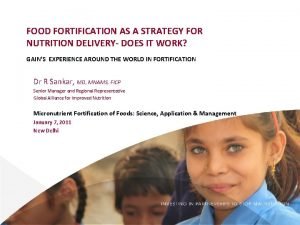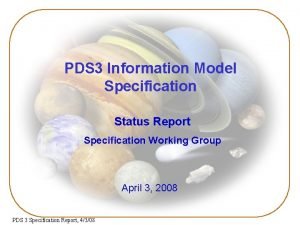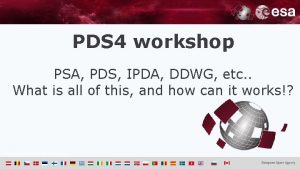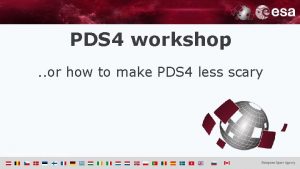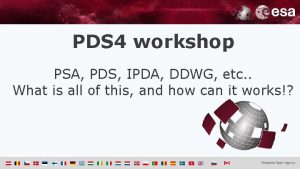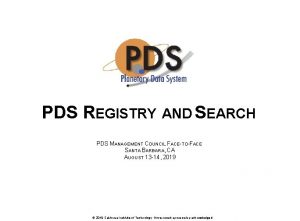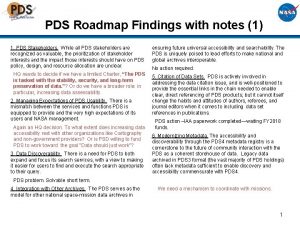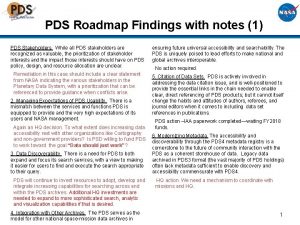PDS Role in Food Fortification ILSI Workshop New

















- Slides: 17

PDS: Role in Food Fortification ILSI Workshop, New Delhi 8 th Jan 2011 Dr. Prakash V Kotecha Country Representative, A 2 Z, the USAID Micronutrient Project, AED New Delhi, India

Micronutrient Malnutrition • Minimal loss to GDP due to Micronutrient deficiencies per year: Rs 27, 720 crores * • People affected to the highest level are from low socio-economic condition. • They suffer the most but have the least resources and so to reach them a special targeted effort is required • PDS exactly wants to do this: reach to targeted poor people with poor access and that is why PDS has important role in supplying fortified foods. *Source: India Micronutrient investment Plan 2007 -2011 MI Publication Kotecha, AED, India 2

Micronutrient Malnutrition • In National Sample Surveys, the percentage of people claiming to be hungry has fallen steadily from 15% in 1983 to 2% in 2004 -5. • The big problem is malnutrition, not hunger. Anemia among pregnant women at 58% and children at 79%, these are not all hungry subjects… • Economists Dreze and Deaton have shown that as incomes rise, poorer Indians opt for superior foods rather than more calories Kotecha, AED, India 3

4 NNMB Study Iron Intake % RDA Age n Iron <50 1 -3 yrs 2673 72. 1 4 -6 yrs 2406 70. 7 7 -9 yrs 2399 76. 2 Boys 10 -12 yrs 1227 80. 7 Girls 10 -12 yrs 1218 77. 5 Boys 13 -15 yrs 921 79. 6 Girls 13 -15 yrs 921 68 Boys 16 -17 yrs 1396 73. 3 Girls 16 -17 yrs 1889 71. 2 Adult Male 2771 50. 1 Adult Female 4799 67. 9 Pregnant Female 188 68. 1 Lactating Female 668 71. 1 Kotecha, AED, India

Poverty Level In India Source: What Is Poverty, Really? The Case of India by Carl Haub and O P Sharma Kotecha, AED, India Jan 2010 Article on Population Reference Bureau 5

Public Distribution System • Started in 1960 s it was for everyone till 1992 when it was tried for tribal blocks of far and difficult areas to improve the reach and in 1997 it was made targeted to poor people • State Government responsibility to identify poor and ensure that they get the benefit • When started it aimed for 6 crore (60 million) people with 72 lakh tones of grains Kotecha, AED, India 6

Public Distribution System • • PDS means distribution of essential commodities to a large number of people through a network of FPS on a recurring basis. The commodities are as follows : Wheat Rice Sugar Kerosene Kotecha, AED, India 7

Public Distribution System in India PDS evolved - major instrument of the Government’s economic policy for ensuring availability of foodgrains at affordable prices It is an important strategy for poverty eradication and is intended to serve as a safety net for the poor nutritionally at risk. PDS with a network of large number of Fair Price Shops (FPS) is perhaps the largest distribution network of its type in the world. Kotecha, AED, India 8

Public Distribution System in India • PDS is operated under the joint responsibility of the Central and the State Governments. • The Central Government responsibility for procurement, storage, transportation and bulk allocation of foodgrains, • The State Governments responsibility – For distributing the same to the consumers through the network of Fair Price Shops (FPSs). – The operational responsibilities including allocation within the State, identification of families below poverty line, issue of ration cards, supervision and monitoring the functioning of FPSs. Kotecha, AED, India 9

Public Distribution System ANTYODAYA ANNA YOJANA (AAY) • In order to make TPDS more focused and targeted towards this category of population, the “Antyodaya Anna Yojana” (AAY) was launched in December, 2000 for one crore poorest of the poor families (increased in by 2009 2. 5 crore people) • Providing them food grains at a highly subsidized rate of Rs. 2/ per kg. for wheat and Rs. 3/ per kg for rice. Kotecha, AED, India 10

Role of PDS in Fortification • Common goal to reach poor and hard to reach people at an affordable cost • System in place and we need to piggy back • Supply fortified atta in place of grains is all that we need to do • Wheat fortification most practical fortified with iron, folic acid, vitamin A, (iodine), in that priority. • Rice fortification and sugar fortification are also promising Kotecha, AED, India 11

12 2010 Quantity: 245, 344 MT/month Population: 44. 52 millions West Bengal Punjab Gujarat Chandigarh Delhi Tamil Nadu Kerala Rajasthan Madhya Pradesh Bihar Kotecha, AED, India

13 FLOUR FORTIFICATION SUCCESS STORY • One state (Tamil Nadu) with mandatory fortification • The projected quantity of fortified flour distribution by end of 2010 would be approx. 3, 20, 344 MT/ month • Approx. 75 million population in India will have the access of fortified wheat flour by the end of 2010 Kotecha, AED, India

Flour Fortification Progress Since 2000: • 44. 5 million people now have access to fortified flour from 1 million in 2000. • Larger proportion of market flour is now fortified than before • The number of states with wheat flour fortification increased from 4 (2008) to 10 (2010). Kotecha, AED, India 14

Challenges of Fortification in PDS • PDS for really poor people? • Fight corruption and ensure that the real targeted population gets it is. Ensure that it is not recirculated in the open market • Who would bear the cost? • How shall the quality will be maintained? • Technology Transfer to Appropriate authority • Accountability between Civil Supply, Health, Social Welfare, whose jurisdiction? • Should it be mandatory? Kotecha, AED, India 15

Challenges of Fortification Technical Aspects • What food to fortify? • What nutrient to use fortification? Iron being the common most… many options available • Most of the wheat atta are not produced centrally and so small chakkis will have to be involved extensively • How much amount of nutrient elements: depends upon the available dietary source that is so variable in Indian population Kotecha, AED, India 16

17 Thank You Kotecha, AED, India
 Food delivery fortification
Food delivery fortification Premix for fortification
Premix for fortification Medolac
Medolac Role play on healthy food and junk food
Role play on healthy food and junk food Role play on healthy food and junk food
Role play on healthy food and junk food Unit 2 food food food
Unit 2 food food food Grazing food chain diagram
Grazing food chain diagram What is web role and worker role in azure
What is web role and worker role in azure Lothar krappmann
Lothar krappmann Statuses and their related roles determine
Statuses and their related roles determine Pds report
Pds report Http://pds.jpl.nasa.gov/planets/
Http://pds.jpl.nasa.gov/planets/ E primo authentification
E primo authentification Employee code of conduct
Employee code of conduct Pds multinational
Pds multinational Corpds
Corpds Pds report
Pds report Precential
Precential
